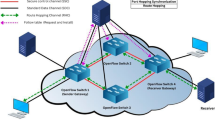Abstract
In more recent years peer-to-peer systems are becoming more popular in the area of research because of possessing a number of challenging issues. The entire P2P research can be divided into four areas: search, storage, security and sharing. In various circumstances, the P2P network makes sense in effective communication. The P2P networking increases the QOS, in terms of communication speed, delay, data success rate and less data loss and so on. Due to its open nature system, it deployed hugely in the area of transferring large files and it easily exposes them to the malicious activities. The election of malicious or compromised peer as a peer head is one of the most significant breaches in peer-to-peer networks. In light of these issues, we focus the improvement of P2P network performance by following the given mechanisms. Mechanism 1: topology construction based on grouping of similar interest peer (GOSIP). Mechanism 2: electing the peer-heads for each GOSIP, based on the trust-threshold value given by each peers about their neighbor peers and considering the MAC address of the top listed peers in each group. In this paper, the P2P functionality is improved in such a way that the number of request is reduced and the neighborhood peers communication is improved by finding optimized neighbor using GOSIP algorithm. We have taken these mechanisms into the test-bed through simulation. The simulations outcomes flashed out clearly that these methods significantly improve 25 % of network Scalability and 50 % of throughputs, in turn improvise the performance of P2P networks efficiently when compared to the existing methodologies.








Similar content being viewed by others
References
Ahmed, M., et al. (2007). A dynamic approach for the selection of super peers in ad hoc networks. In Proceedings of the sixth international conference on networking (ICN’07), IEEE.
Clarke, I. (2001). Freenet: A distributed anonymous information storage and retrieval system. http://freenetproject.org/cgi-bin/twiki/view/Main/ICSI
David, R., et al. (2004). Simple efficient load balancing algorithms for peer-to-peer systems. In SPAA ’04.
Eunyoung, K., & Ungmo, K. (2007). Connection-degree based search and replication in mobile unstructured peer-to-peer networks. In Proceedings of the 2007 international conference on convergence information technology (pp. 919–924).
Gnutella. (2001). Gnutella protocol specification v0.4. http://www.clip2.com/GnutellaProtocol04.pdf
He, Q., et al. (2013). A decentralized service discovery approach on peer-to-peer network. IEEE Transactions on Services Computing, 6(1), 64–75.
ICOIN. (2008, January 23–25). International conference on information networking.
Jung, S. H., et al. (2008). Mobile peer-to-peer systems using super peers for mobile environments.
Khalid, E., et al. (2013). RobP2P: A robust architecture for resource sharing in mobile peer-to-peer networks. Procedia Computer Science, 19, 356–363.
Kwong, K. W., & Tsang, D. H. K. (2008). Building heterogeneous peer-to-peer networks: Protocol and analysis. IEEE/ACM Transactions on Networking, 16, 281.
Ledlie, J., et al. (2002). Scaling filename queries in a large-scale distributed file system. Research report TR-03-02, Harvard University, January 2002.
Li, X., et al. (2005). Dynamic layer management in superpeer architectures. IEEE Transactions on Parallel and Distributed Systems, 16(11), 1078–1091.
Mekouar, L., et al. (2006). Peer-to-peer’s most wanted: Malicious peers. International Computer Networks Journal, 50(4), 545–562.
Pawel, G., et al. (2007). Optimizing peer relationships in a super-peer network. In IEEE transactions on distributed computing system (p. 31), 25–27 June 2007.
Proceedings of the sixteenth annual ACM symposium on parallelism in algorithms and architectures (pp. 36–43). New York, NY.
Rajesh, S. & Anwitaman, D. (2012). SuperNova: Super-peers based architecture for decentralized online social networks, IEEE.
Saroiu, S., et al. (2002, January). A measurement study of peer-to-peer file sharing systems. In Proceedings of the multimedia computing and networking (MMCN), San Jose, CA.
Singla, A., & Rohrs, C. (2002, November). Ultrapeers: another step towards gnutella scalability.
Stoica, I., et al. (2001, August). A scalable peer-to-peer lookup service for internet applications. In Proceedings of the ACM SIGCOMM ’01 conference.
Xiaosong, L., & Kai, H. (2008). Proactive content poisoning to prevent collusive piracy in P2P file sharing. IEEE Transactions on Computers TC -2007-09-0492R2. Revised April 8, 2008.
Xiang, Y. H., et al. (2010). The resource discovery algorithm based on super-peer in mobile peer-to-peer network. Journal of Chinese Computer Systems, 31(10), 31.
Author information
Authors and Affiliations
Corresponding author
Rights and permissions
About this article
Cite this article
Venkadeshan, R., Chandrasekar, M. Effective Communication in P2P Network by Introducing GOSIP–PHE Algorithms. Wireless Pers Commun 87, 923–937 (2016). https://doi.org/10.1007/s11277-015-2625-6
Published:
Issue Date:
DOI: https://doi.org/10.1007/s11277-015-2625-6




